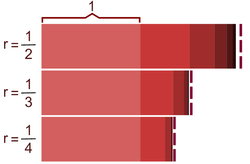One, Three, Nine, Twenty Seven
 1
+
3
1
+
9
1
+
2
7
1
+
…
1
+
3
1
+
9
1
+
2
7
1
+
…
What is the value of the above series?
Image Credit: Wikimedia Geometric Progression
The answer is 1.5.
This section requires Javascript.
You are seeing this because something didn't load right. We suggest you, (a) try
refreshing the page, (b) enabling javascript if it is disabled on your browser and,
finally, (c)
loading the
non-javascript version of this page
. We're sorry about the hassle.
8 solutions
Let the expression equals to x
x = 1 + 3 1 + 9 1 + 2 7 1 + …
x = 1 + 3 1 + 3 × 3 1 + 3 × 9 1 + …
x = 1 + 3 1 × x ( 1 + 3 1 + 9 1 + 2 7 1 + … )
x = 1 + 3 1 × x
x − 1 = 3 x
3 ( x − 1 ) = x
x = 2 3
How did u take that common??
Thinking of it in Base-three, each place value is a power of three.
It becomes 1 + .1 + .01 + .001 +... = 1.11111111111...
Then similar to Muhammad Ardivan's solution:
Let x = 1.11111111111... and 10x = 11.11111111111...
(Remember we're in base-three where you write three as 10
and just shift the decimal point once to the right when you
multiply by three.)
10x = 11.11111111111...
- 1x = 1.11111111111...
so on the left:
10x - 1x (three x minus one x) = 2x
and on the right:
11.11111111111...
-1.11111111111...
======================
10.00000000000...
So 2x = 10 (three)
Divide both sides by 2
x = half of three = 1½
The sum of geometric progression with infinitely many terms is given by
S = 1 − r a 1 where a 1 = first term and r = common ratio
From the given geometric progression,
r = 2 7 1 ÷ 9 1 = 9 1 ÷ 3 1 = 3 1 ÷ 1 = 3 1
So the sum of the progression is,
S = 3 1 1 = 2 3 = 1 . 5
The image above shows the solution. The red bars depict the sums of 3 different infinite series by representing each consecutive fraction in the series as a shaded region with a length as a fraction of the first region. r=1/2 bar has a total length of 2. The length of the r=1/3 bar, when measured against the bar above, measures 1.5. So once you discover that r is 1/3 you can use the image to determine the length of the bar.
Alternatively (and this is what I did), you can just recall that the sum of an infinite series is the first term divided by 1-r, and you get 1/(1-(1/3)) = 1(2/3) = (3/2) = 1.5
Similar to @samuel ayinde
1 − r a = 1 − 3 1 1 = 2 3 = 1 . 5
I bet that my method is a simple one, 1 + 3 1 + 9 1 + … ⋯ = p . . . . . . ⓵
Times both side by three,
3 + 1 + 3 1 + 9 1 + … ⋯ = 3 p . . . . . . . . ⓶
⓶ - ⓵: 3 p − p = 3 Hence, answer is 1.5
Sum of geometric series
S_\inf=a/(1-r)
S_\inf=1/(1-1/3)
Multiply numerator and denominator by 3.
S_\inf=3/(3-1)
S_\inf=3/2=1.5
This is sum to infinity. S ∞ = 1 − r a
S ∞ = 1 − 3 1 1
S ∞ = 1 divided by 3 2
S ∞ = 2 3
S ∞ = 1 . 5